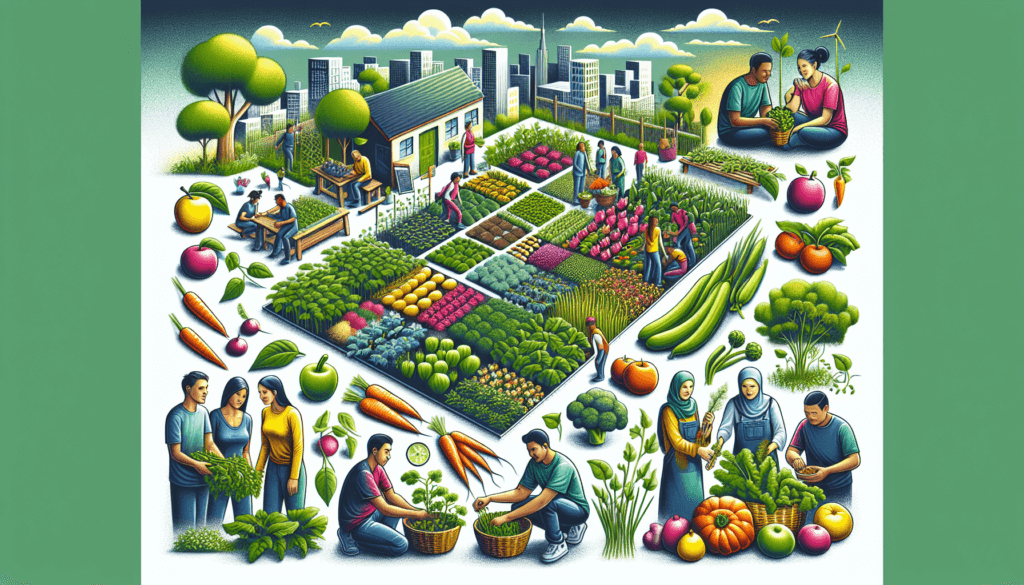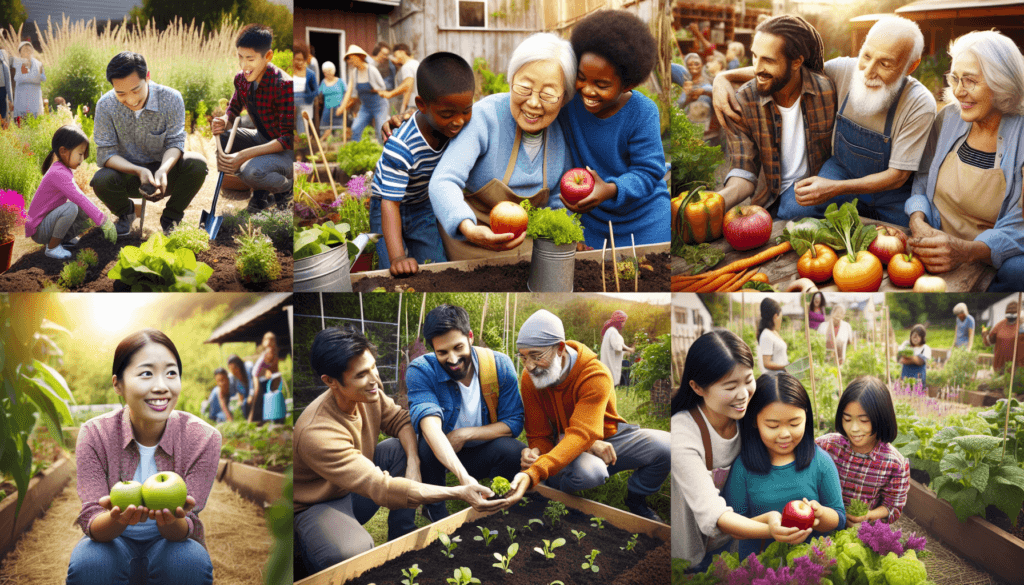Imagine a vibrant space filled with lush greenery, colorful flowers, and the joyful laughter of neighbors mingling together. This is the essence of a community garden, an enchanting oasis tucked away in the heart of a bustling city. More than just a collection of plants, a community garden is where individuals from diverse backgrounds come together to cultivate not only the soil but also a sense of belonging, connection, and shared responsibility. In this article, we will explore the defining characteristics of a community garden, from its inclusive nature to the multitude of benefits it brings to those involved. So, grab your gardening gloves, because we’re about to uncover the essence of what makes these gardens truly special.
1. Purpose of a Community Garden
Community gardens serve multiple purposes and contribute to the well-being of individuals and communities in various ways.
1.1 Providing Access to Fresh Food
One of the primary purposes of a community garden is to provide access to fresh and healthy food for individuals who may not have access to grocery stores or affordable produce. In communities where there are food deserts or limited access to fresh produce, community gardens play a crucial role in addressing this issue. By growing fruits, vegetables, and herbs locally, community gardens enable community members to have a reliable source of nutritious food.
1.2 Promoting Sustainable Practices
Community gardens also serve as a platform to promote sustainable gardening practices. Through the use of organic methods, such as composting, mulching, and water conservation techniques, community gardens minimize the use of harmful chemicals and reduce their environmental impact. By adopting sustainable practices, community gardens contribute to the preservation of natural resources and promote a more sustainable way of living.
1.3 Fostering Social Connection and Engagement
Another significant purpose of a community garden is to create a sense of social connection and engagement among community members. Community gardens provide a space where individuals from diverse backgrounds can come together, share their knowledge and experiences, and work towards a common goal. This shared space fosters a sense of community, strengthens social bonds, and creates opportunities for collaboration and friendship among neighbors.
2. Types of Community Gardens
Community gardens come in various forms and cater to different needs and interests of the community. Here are some common types of community gardens:
2.1 Allotment Gardens
Allotment gardens are individual plots of land that community members can rent and cultivate for their own personal use. Each individual is responsible for maintaining their plot and can grow whatever plants they desire. Allotment gardens provide individuals with the freedom to grow their preferred plants and vegetables, enabling them to have a sense of ownership and pride in their garden.
2.2 Neighborhood Gardens
Neighborhood gardens are communal spaces where community members collectively grow and maintain the garden. These gardens usually have a shared responsibility, and individuals work together to plan, plant, and care for the garden. Neighborhood gardens encourage collaboration and facilitate the exchange of ideas and experiences among participants.
2.3 School Gardens
School gardens are located on school grounds and serve as an educational tool for students. These gardens provide hands-on learning opportunities where students can learn about plant life cycles, environmental stewardship, and sustainable gardening practices. School gardens also promote healthy eating habits by showcasing the benefits of fresh, homegrown produce.
2.4 Therapeutic Gardens
Therapeutic gardens are specifically designed to promote physical and mental well-being. These gardens often include features such as sensory plants, accessible pathways, and seating areas for relaxation and reflection. Therapeutic gardens are utilized as a therapeutic tool by healthcare facilities, rehabilitation centers, and community organizations to improve the overall well-being of individuals.
2.5 Rooftop Gardens
Rooftop gardens are community gardens established on the rooftops of buildings. These gardens maximize the use of available space in urban areas where ground space might be limited. Rooftop gardens provide numerous benefits, including insulation, stormwater management, and urban heat island mitigation, while also providing a green oasis for community members.
2.6 Guerrilla Gardens
Guerrilla gardens are community gardens that are established on unused or neglected public spaces without permission. Often seen as acts of activism, guerrilla gardens aim to beautify and reclaim abandoned areas for the benefit of the community. These gardens have the potential to inspire positive change and encourage community involvement in revitalizing neglected spaces.
2.7 Pocket Parks
Pocket parks are small community gardens that are created within densely populated urban areas. These parks provide a place for relaxation and recreation, allowing community members to escape the busy city environment and connect with nature. Pocket parks can have various features, including seating areas, small playgrounds, and gardens, making them valuable assets within urban landscapes.

3. Size and Location
The size and location of a community garden are crucial factors to consider in order to create an effective and accessible space for community members.
3.1 Available Land
The availability of land will determine the size of the community garden. It is important to assess the amount of land that can be allocated to the garden, taking into consideration factors such as soil quality, sunlight exposure, and access to water sources. Community members should work together with local authorities or landowners to secure a suitable plot of land for their garden.
3.2 Urban vs. Rural Locations
Community gardens can be established in both urban and rural locations, each with its unique benefits and challenges. Urban community gardens provide access to green spaces within heavily built-up areas, allowing residents to reconnect with nature. On the other hand, rural community gardens can leverage larger plots of land and potentially produce a higher volume of crops.
3.3 Accessibility
The location of a community garden should be easily accessible to community members, including those with physical disabilities or limited mobility. Consideration should be given to proximity to public transportation, availability of parking spaces, and the presence of wheelchair-accessible pathways. Ensuring accessibility allows all community members to participate and benefit from the garden’s activities.
4. Ownership and Management
The ownership and management structure of a community garden can vary depending on the goals, resources, and preferences of the community.
4.1 Public Gardens
Public community gardens are owned and managed by local governments or municipalities. These gardens often operate under specific rules and regulations set by the governing body. Public gardens can provide stability and resources, such as water sources and infrastructure, which can benefit the community members.
4.2 Private Gardens
Private community gardens are owned and managed by a specific organization or individual. These gardens might require membership or rental fees to cover maintenance costs and resources. Private gardens can offer more flexibility in terms of design and management, allowing community members to have a higher level of involvement in decision-making.
4.3 Collective Gardens
Collective community gardens are jointly owned and managed by a group of community members. This collaborative approach allows for shared decision-making, workload, and responsibilities. Collective gardens often operate under a set of agreed-upon rules and may require regular meetings or assemblies to address garden-related matters.

5. Design and Layout
The design and layout of a community garden play a crucial role in maximizing the functionality and aesthetics of the space.
5.1 Plot Arrangement
The arrangement of individual plots within the community garden should be carefully planned to optimize space usage and ensure accessibility. Consideration should be given to factors such as sunlight exposure, irrigation needs, and compatibility of plants. Additionally, the layout should allow for easy movement between plots and common areas.
5.2 Pathways
Well-designed pathways are essential for easy navigation and accessibility within the community garden. Pathways should be wide enough to accommodate wheelchair users and individuals with strollers, while also providing a clear route for gardeners to access their plots. The use of materials such as gravel, wood chips, or concrete can help create stable and durable pathways.
5.3 Common Areas
Community gardens should include designated common areas where gardeners can gather, socialize, and collaborate on various activities. These spaces can be equipped with picnic tables, seating areas, or communal gardening tools. Common areas foster a sense of community and create opportunities for knowledge sharing and bonding among gardeners.
5.4 Water Sources
Access to a reliable water source is essential for the success of a community garden. The garden design should include strategically placed water sources, such as faucets or rainwater harvesting systems. Adequate irrigation options ensure that plants receive the necessary water throughout the growing season, reducing reliance on external water sources and minimizing waste.
5.5 Tools and Equipment
Community gardens should provide shared tools and equipment to enable gardeners to cultivate their plots efficiently. Tools such as shovels, hoes, and watering cans can be stored in designated tool sheds or communal storage areas. Availability and proper maintenance of tools are crucial to ensure that all gardeners have access to the necessary equipment.
6. Membership and Participation
Establishing clear membership guidelines and encouraging active participation are key to creating a thriving and inclusive community garden.
6.1 Membership Criteria
Community gardens typically have membership criteria that govern who can join and participate in the garden activities. These criteria may include residency requirements, payment of dues or fees, and adherence to garden rules and regulations. Clear membership criteria ensure that all participants are committed to the garden’s success and contribute to the community.
6.2 Roles and Responsibilities
Defining roles and responsibilities helps distribute the workload and ensures that all necessary tasks are addressed. This can include assigning responsibilities for maintenance, watering schedules, organizing events, and communicating with the larger community. Clearly defined roles and responsibilities promote accountability and help create a well-functioning and harmonious community garden.
6.3 Volunteering Opportunities
Encouraging community members to volunteer their time and skills can enhance the sense of ownership and pride in the community garden. Volunteering opportunities can include organizing workshops, leading educational programs, or assisting with garden maintenance. These opportunities foster a spirit of community engagement and create a space for individuals to share their expertise and passion with others.

7. Community Support and Partnerships
Community gardens thrive with the support and partnerships of local organizations, governments, and businesses.
7.1 Local Government Support
Local governments can provide resources, funding, and guidance to community gardens. They may assist in land allocation, provide water access, or offer technical expertise. Working closely with local government entities can help ensure the long-term sustainability and success of community gardens.
7.2 Non-Profit Organizations
Non-profit organizations focused on community development, sustainability, or food security can provide valuable support to community gardens. These organizations may offer grants, educational programs, or networking opportunities. Partnering with non-profit organizations can help community gardens access additional resources and expand their impact within the community.
7.3 Business and Corporate Sponsorship
As community gardens gain recognition and popularity, businesses and corporations may be interested in sponsoring or supporting their initiatives. Sponsorship can come in the form of financial support, donations of materials or equipment, or volunteer participation. Collaborating with businesses and corporate sponsors can provide community gardens with additional resources, exposure, and networking opportunities.
8. Education and Community Programs
Education and community programs play a vital role in community gardens by promoting skill development, fostering food education, and engaging diverse groups within the community.
8.1 Gardening Workshops
Gardening workshops provide community members with the opportunity to learn and develop essential gardening skills. These workshops can cover a range of topics, from basic gardening techniques to specialized areas such as composting, pest management, or seed saving. By offering workshops, community gardens empower individuals to grow their own food and become more self-sufficient gardeners.
8.2 Food Education Programs
Food education programs within community gardens educate participants about the benefits of healthy eating and the importance of fresh, locally grown produce. These programs can include cooking demonstrations, nutrition workshops, or culinary classes using ingredients harvested from the garden. Food education programs enable community members to make informed choices about their food and lead healthier lifestyles.
8.3 Youth and Senior Programs
Engaging youth and seniors in community gardens provides unique opportunities for intergenerational connection and learning. Youth programs can focus on environmental education, teaching children about sustainable gardening practices and fostering a sense of responsibility towards the environment. Similarly, senior programs offer seniors the chance to engage in physical activity, socialize, and share their gardening wisdom with younger generations.

9. Benefits of Community Gardens
Community gardens offer a wide range of benefits to individuals and communities alike.
9.1 Improved Food Security
By providing access to fresh, locally grown food, community gardens contribute to improved food security. Individuals and families who face barriers to obtaining nutritious food can rely on community gardens to access affordable and healthy produce. Community gardens help reduce food insecurity and create a more resilient and self-sufficient community.
9.2 Environmental Benefits
Community gardens play a crucial role in promoting environmental sustainability. Through the adoption of organic gardening practices, such as composting and water conservation, community gardens contribute to the preservation of natural resources and reduction of environmental harm. Moreover, the presence of localized green spaces enhances biodiversity and improves air quality, creating a healthier environment for all.
9.3 Health and Well-being
Engaging in gardening activities has been linked to numerous physical and mental health benefits. Community gardening provides opportunities for physical exercise, stress reduction, and improved overall well-being. Connecting with nature and fostering social connections within community gardens can also have positive effects on mental health, combating social isolation and improving overall life satisfaction.
9.4 Skill and Knowledge Sharing
Community gardens create a platform for skill and knowledge sharing among participants. Individuals with varying levels of gardening experience can learn from one another, exchanging tips, techniques, and best practices. This collaborative learning environment empowers community members to develop new skills and gain confidence in their abilities, leading to personal growth and a strong sense of community.
10. Challenges and Solutions
While community gardens offer numerous benefits, they also face certain challenges. Here are some common challenges and possible solutions:
10.1 Land Availability
Securing land for community gardens can be a significant challenge, especially in urban areas where land is limited and expensive. Engaging with local governments and relevant stakeholders to identify underutilized or vacant spaces can help address this issue. Additionally, community gardens can explore creative solutions such as rooftop gardens, vertical gardening, or establishing partnerships that allow gardens to thrive in unconventional spaces.
10.2 Limited Resources
Community gardens often face limitations in terms of funding, equipment, and materials. To overcome these challenges, community gardens can seek partnerships with businesses, apply for grants, and engage in fundraising activities. Establishing a shared tool library or resource exchange program among garden members can also help maximize the efficient use of available resources.
10.3 Community Engagement
Maintaining community engagement and consistent participation can be a persistent challenge for community gardens. Regular communication, events, and educational programs can help keep community members engaged and motivated. Implementing a mentorship program where experienced gardeners guide and support new participants can also foster a sense of responsibility and investment within the community.
10.4 Maintenance and Sustainability
Sustaining the long-term operation and maintenance of a community garden requires careful planning and organization. Creating a clear maintenance schedule and assigning responsibilities to different individuals or groups can help distribute the workload and ensure the garden’s sustainability. Regular community workdays and volunteer opportunities can also encourage active involvement and ownership, strengthening the garden’s resilience.
In conclusion, community gardens serve as valuable spaces that address various needs of individuals and communities. They provide access to fresh food, promote sustainable practices, and foster social connection and engagement. With different types, sizes, and locations, community gardens cater to diverse interests and demographics. Ownership and management structures, along with well-thought-out design and layout, are crucial in creating successful community gardens. Membership criteria, roles and responsibilities, and volunteer opportunities promote community participation. Community support, partnerships, and education programs contribute to the overall success of community gardens. The benefits of community gardens include improved food security, environmental sustainability, enhanced health and well-being, and skill and knowledge sharing. Despite the challenges they face, community gardens can overcome obstacles through creative solutions and a strong sense of community. By recognizing the importance of community gardens and supporting their development, individuals and communities can cultivate a greener, healthier, and more connected future.



